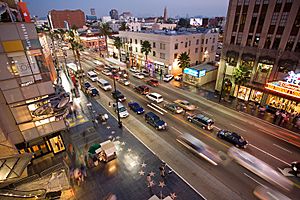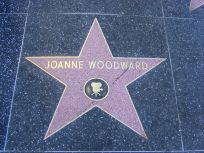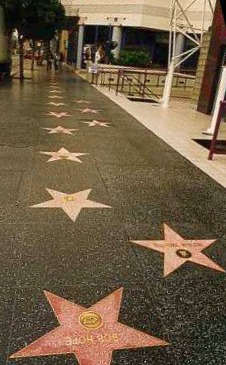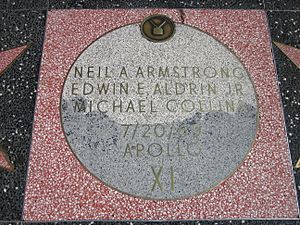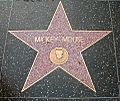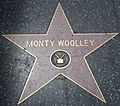Hollywood Walk of Fame facts for kids
The Hollywood Walk of Fame is a sidewalk along Hollywood Boulevard and Vine Street in Hollywood, Los Angeles, California, USA, that is like an entertainment museum. There are over 2500 stars on the sidewalk. The names of famous entertainers and famous fictional characters are written on the stars.
The Hollywood Walk of Fame comprises more than 2,600 five-pointed terrazzo and brass stars embedded in the sidewalks along 15 blocks of Hollywood Boulevard and three blocks of Vine Street in Hollywood, California. The stars are permanent public monuments to achievement in the entertainment industry, bearing the names of a mix of actors, musicians, directors, producers, musical and theatrical groups, fictional characters, and others. The Walk of Fame is administered by the Hollywood Chamber of Commerce and maintained by the self-financing Hollywood Historic Trust. It is a popular tourist destination, with a reported 10 million visitors in 2003.
Contents
Description
The Walk of Fame runs 1.3 miles (2.1 km) east to west on Hollywood Boulevard from Gower Street to La Brea Avenue, plus a short segment of Marshfield Way that runs diagonally between Hollywood and La Brea; and 0.4 miles (0.64 km) north to south on Vine Street between Yucca Street and Sunset Boulevard. According to a 2003 report by the market research firm NPO Plog Research, the Walk attracts about 10 million visitors annually—more than Sunset Strip, TCL Chinese Theatre (formerly Grauman's), the Queen Mary, and the Los Angeles County Museum of Art—and has played an important role in making tourism the largest industry in Los Angeles County.
Categorization
As of 2017[update], the Walk of Fame comprises over 2,600 stars, spaced at 6-foot (1.8 m) intervals. The monuments are coral-pink terrazzo five-point stars rimmed with brass (not bronze, an oft-repeated inaccuracy) inlaid into a charcoal-colored terrazzo background. In the upper portion of each star field the name of the honoree is inlaid in brass block letters. Below the inscription, in the lower half of the star field, a round inlaid brass emblem indicates the category of the honoree's contributions. The emblems symbolize five categories within the entertainment industry:
Classic film camera representing motion pictures
Television receiver representing broadcast television
Phonograph record representing audio recording or music
Radio microphone representing broadcast radio
Comedy/tragedy masks representing theatre/live performance (added in 1984)
Of all the stars on the Walk to date, 47% have been awarded in the motion pictures category, 24% in television, 17% in audio recording, 10% in radio, and less than 2% in the live performance category. Approximately 20 new stars are added to the Walk each year.
Special stars
Special category stars recognize various contributions by corporate entities, service organizations, and special honorees, and display emblems unique to those honorees. For example, former Los Angeles mayor Tom Bradley's star displays the Seal of the City of Los Angeles;
The monuments for the Apollo 11 mission to the Moon are uniquely shaped: Four identical circular moons, bearing the names of the three astronauts (Neil A. Armstrong, Edwin E. Aldrin Jr., Michael Collins) the date of the first Moon landing ("7/20/69"), and the words "Apollo XI", are set on each of the four corners of the intersection of Hollywood and Vine. The moons are silver and grey terrazzo circles rimmed in brass on a square pink terrazzo background, with the television emblem inlaid at the top of each circle.
History
Origin
The Hollywood Chamber of Commerce credits E.M. Stuart, its volunteer president in 1953, with the original idea for creating a Walk of Fame. Stuart reportedly proposed the Walk as a means to "maintain the glory of a community whose name means glamour and excitement in the four corners of the world." Harry Sugarman, another Chamber member and president of the Hollywood Improvement Association, received credit in an independent account. A committee was formed to flesh out the idea, and an architectural firm was retained to develop specific proposals. By 1955, the basic concept and general design had been agreed upon, and plans were submitted to the Los Angeles City Council.
Multiple accounts exist for the origin of the star concept. According to one, the historic Hollywood Hotel—which stood for more than 50 years on Hollywood Boulevard at the site now occupied by the Hollywood and Highland complex and the Dolby (formerly Kodak) Theatre—displayed stars on its dining room ceiling above the tables favored by its most famous celebrity patrons, and that may have served as an early inspiration. By another account, the stars were "inspired ... by Sugarman's Tropics Restaurant drinks menu, which featured celebrity photos framed in gold stars."
In February 1956, a prototype was unveiled featuring a caricature of an example honoree (John Wayne, by some accounts) inside a blue star on a brown background. However, caricatures proved too expensive and difficult to execute in brass with the technology available at the time; and the brown and blue motif was vetoed by Charles E. Toberman, the legendary real estate developer known as "Mr. Hollywood", because the colors clashed with a new building he was erecting on Hollywood Boulevard.
Selection and construction
By March 1956, the final design and coral-and-charcoal color scheme had been approved. Between the spring of 1956 and the fall of 1957, 1,558 honorees were selected by committees representing the four major branches of the entertainment industry at that time: motion pictures, television, audio recording, and radio. The committees met at the Brown Derby restaurant, and included such prominent names as Cecil B. DeMille, Samuel Goldwyn, Jesse L. Lasky, Walt Disney, Hal Roach, Mack Sennett, and Walter Lantz.
A requirement stipulated by the original audio recording committee (and later rescinded) specified minimum sales of one million records or 250,000 albums for all music category nominees. The committee soon realized that many important recording artists would be excluded from the Walk by that requirement. As a result, the National Academy of Recording Arts and Sciences was formed to create a separate award for the music industry, leading to the first Grammy Awards in 1959.
Construction of the Walk began in 1958 but two lawsuits delayed completion. The first lawsuit was filed by local property owners challenging the legality of the $1.25 million tax assessment levied upon them to pay for the Walk, along with new street lighting and trees. In October 1959, the assessment was ruled legal. The second lawsuit, filed by Charles Chaplin Jr., sought damages for the exclusion of his father, whose nomination had been withdrawn due to pressure from multiple quarters (see Controversial additions). Chaplin's suit was dismissed in 1960, paving the way for completion of the project.
While Joanne Woodward is often singled out as the first person to receive a star on the Walk of Fame, possibly because she was the first to be photographed with hers, the original stars were installed as a continuous project, with no individual ceremonies. Woodward's name was one of eight drawn at random from the original 1,558 and inscribed on eight prototype stars that were built while litigation was holding up permanent construction. The eight prototypes were installed temporarily on the northwest corner of Hollywood Boulevard and Highland Avenue in August 1958 to generate publicity and to demonstrate how the Walk would eventually look. The other seven names were Olive Borden, Ronald Colman, Louise Fazenda, Preston Foster, Burt Lancaster, Edward Sedgwick, and Ernest Torrence. Official groundbreaking took place on February 8, 1960. On March 28, 1960, the first permanent star, director Stanley Kramer's, was completed on the easternmost end of the new Walk near the intersection of Hollywood and Gower.
Stagnation and revitalization
Though the Walk was originally conceived in part to encourage redevelopment of Hollywood Boulevard, the 1960s and 1970s were periods of protracted urban decay in the Hollywood area as residents moved to nearby suburbs. After the initial installation of approximately 1,500 stars in 1960 and 1961, eight years passed without the addition of a new star. In 1962, the Los Angeles City Council passed an ordinance naming the Hollywood Chamber of Commerce "the agent to advise the City" about adding names to the Walk, and the Chamber, over the following six years, devised rules, procedures, and financing methods to do so. In December 1968, Richard D. Zanuck was awarded the first star in eight years in a presentation ceremony hosted by Danny Thomas. In July 1978, the City of Los Angeles designated the Hollywood Walk of Fame a Los Angeles Historic-Cultural Monument.
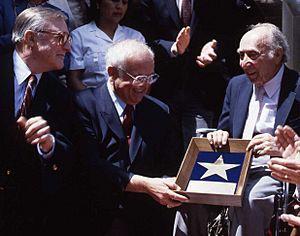
Radio personality, television producer and Chamber member Johnny Grant is generally credited with implementing the changes that resuscitated the Walk and established it as a significant tourist attraction. Beginning in 1968, Grant stimulated publicity and encouraged international press coverage by requiring that each recipient personally attend his or her star's unveiling ceremony. Grant later recalled that "it was tough to get people to come accept a star" until the neighborhood finally began its recovery in the 1980s. In 1980, he instituted a fee of $2,500, payable by the person or entity nominating the recipient, to fund the Walk of Fame's upkeep and minimize further taxpayer burden. The fee has increased incrementally over time; by 2002 it had reached $15,000, and stood at $30,000 in 2012. As of 2020[update], the fee is $50,000.
Grant was awarded a star in 1980 for his television work. In 2002, he received a second star in the "special" category to acknowledge his pivotal role in improving and popularizing the Walk.
Expansion
In 1984, a fifth category, Live Theatre, was added to acknowledge contributions from the live performance branch of the entertainment industry, and a second row of stars was created on each sidewalk to alternate with the existing stars.
In 1994, the Walk of Fame was extended one block to the west on Hollywood Boulevard, from Sycamore Avenue to North LaBrea Avenue (plus the short segment of Marshfield Way that connects Hollywood and La Brea), where it now ends at the silver "Four Ladies of Hollywood" gazebo and the special "Walk of Fame" star. At the same time, Sophia Loren was honored with the 2,000th star on the Walk.
During construction of tunnels for the Los Angeles subway system in 1996, the Metropolitan Transportation Authority (MTA) removed and stored more than 300 stars. Controversy arose when the MTA proposed a money-saving measure of jackhammering the 3-by-3-foot terrazzo pads, preserving only the brass lettering, surrounds, and medallions, then pouring new terrazzo after the tunnels were completed; but the Cultural Heritage Commission ruled that the star pads were to be removed intact.
Restoration
In 2008 a long-term restoration project began with an evaluation of all 2,365 stars on the Walk at the time, each receiving a letter grade of A, B, C, D, or F. Honorees whose stars received F grades, indicating the most severe damage, were Joan Collins, Peter Frampton, Dick Van Patten, Paul Douglas, Andrew L. Stone, Willard Waterman, Richard Boleslavsky, Ellen Drew, Frank Crumit, and Bobby Sherwood. Fifty celebrities' stars received "D" grades. The damage ranged from minor cosmetic flaws caused by normal weathering to holes and fissures severe enough to constitute a walking hazard. Plans were made to repair or replace at least 778 stars at an estimated cost of over $4 million.
The restoration is a collaboration among the Hollywood Chamber of Commerce and various Los Angeles city and county governmental offices, along with the MTA, which operates the Metro B Line that runs beneath the Walk, since earth movement due to the presence of the subway line is thought to be partly responsible for the damage.
To encourage supplemental funding for the project by corporate sponsors, the "Friends of Walk of Fame" program was inaugurated, with donors recognized through honorary plaques adjacent to the Walk of Fame in front of the Dolby Theatre. The program has received some criticism; Alana Semuels of the Los Angeles Times described it as "just the latest corporate attempt to buy some good buzz," and quoted a brand strategist who said, "I think Johnny Grant would roll over in his grave."
In June 2019, The City of Los Angeles commissioned Gensler architects to provide a master plan for a $4 million renovation to improve and "update the streetscape concept" for the Walk of Fame with the goal of improving the public right-of-way.
Nomination process

Each year an average of 200 nominations are submitted to the Hollywood Chamber of Commerce Walk of Fame selection committee. Anyone, including fans, can nominate anyone active in the field of entertainment as long as the nominee or his or her management approves the nomination. Nominees must have a minimum of five years' experience in the category for which they are nominated and a history of "charitable contributions." Posthumous nominees must have been deceased at least five years. At a meeting each June, the committee selects approximately 20 to 24 celebrities to receive stars on the Walk of Fame. One posthumous award is given each year as well. The nominations of those not selected are rolled over to the following year for reconsideration; those not selected two years in a row are dropped, and must be renominated to receive further consideration. Living recipients must agree to personally attend a presentation ceremony within two years of selection. If the ceremony is not scheduled within two years, a new application must be submitted. A relative of deceased recipients must attend posthumous presentations. Presentation ceremonies are open to the public.
A fee of $50,000 (as of 2020[update]), payable at time of selection, is collected to pay for the creation and installation of the star, as well as general maintenance of the Walk of Fame. The fee is usually paid by the nominating organization, which may be a fan club, film studio, record company, broadcaster, or other sponsor involved with the prospective honoree. The Starz cable network, for example, paid for Dennis Hopper's star as part of the promotion for its series Crash.
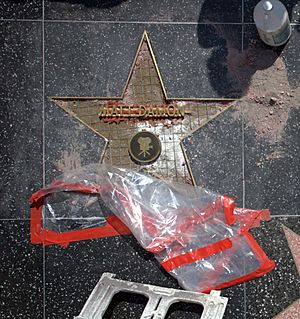
Traditionally, the identities of selection committee members, other than its chairman, have not been made public in order to minimize conflicts of interest and to discourage lobbying by celebrities and their representatives (a significant problem during the original selections in the late 1950s). However, in 1999, in response to intensifying charges of secrecy in the selection process, the Chamber disclosed the members' names: Johnny Grant, the longtime chair and representative of the television category; Earl Lestz, president of Paramount Studio Group (motion pictures); Stan Spero, retired manager with broadcast stations KMPC and KABC (radio); Kate Nelson, owner of the Palace Theatre (live performance); and Mary Lou Dudas, vice president of A&M Records (recording industry). Since that 1999 announcement the chamber has revealed only that Lestz (who received his own star in 2004) became chairman after Grant died in 2008. Their current official position is that "each of the five categories is represented by someone with expertise in that field."
In 2010, Lestz was replaced as chairman by John Pavlik, former Director of Communications for the Academy of Motion Picture Arts and Sciences. While no public announcement was made to that effect, he was identified as chairman in the Chamber's press release announcing the 2011 star recipients. The current chair, according to the Chamber's 2016 selection announcement, is film producer Maureen Schultz.
Rule adjustments
Walk of Fame rules prohibit consideration of nominees whose contributions fall outside the five major entertainment categories, but the selection committee has been known to adjust interpretations of their rules to justify a selection. The Walk's four round Moon landing monuments at the corners of Hollywood and Vine, for example, officially recognize the Apollo 11 astronauts for "contributions to the television industry". Johnny Grant acknowledged, in 2005, that classifying the first Moon landing as a television entertainment event was "a bit of a stretch". Magic Johnson was added to the motion picture category based on his ownership of the Magic Johnson Theatre chain, citing as precedent Sid Grauman, builder of Grauman's (now TCL) Chinese Theatre.
Muhammad Ali's star was granted after the committee decided that boxing could be considered a form of "live performance". Its placement, on a wall of the Dolby Theatre, makes it the only star mounted on a vertical surface, acceding to Ali's request that his name not be walked upon, because he shared his name with the Prophet Muhammad.
All living honorees have been required since 1968 to personally attend their star's unveiling, and approximately 40 have declined the honor due to this condition. The only recipient to date who failed to appear after agreeing to do so was Barbra Streisand, in 1976. Her star was unveiled anyway, near the intersection of Hollywood and Highland. Streisand did attend when her husband, James Brolin, unveiled his star in 1998 two blocks to the east.
Images for kids
-
Harrison Ford's star, presented to the actor in 2003. The silent film actor of the same name has an identical star in a different location on Hollywood Boulevard
See also
 In Spanish: Paseo de la fama de Hollywood para niños
In Spanish: Paseo de la fama de Hollywood para niños



